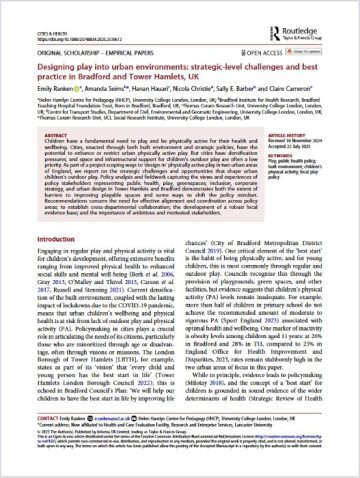Play in urban spaces for health (PUSH)
Theme Diet and physical activity
Workstream Population diet and physical activity
Status: This project is ongoing
Playing outdoors is a good way for children to get physically active. It helps their health, fitness and overall wellbeing. Physical play can also improve their cognitive, social and emotional development by making them interact with peers and use their imagination.
However, access to outdoor play areas in an urban environment can be challenging. For example, over 50 per cent of households in central Bradford don’t have access to a private or shared garden.
The Play in Urban Spaces for Health (PUSH) project is aimed at designing play into urban spaces such as built-up areas and concrete spaces, where children live, shop and go to school. Making these urban spaces more play-friendly could involve:
- Moving away from traditional play equipment
- Thinking more about landscaping
- Incorporating playable features into the urban environment
This project aims to address the inequities in access to play spaces in urban areas of Bradford and Tower Hamlets, as these areas are affected by high deprivation and poor health outcomes.
Project aims
During this project, our colleagues at the Bradford Institute for Health Research will:
- Design the intervention
- Investigate how to influence policy level change
- Explore how to support the development of sites suitable for the PUSH intervention
- Identify ways of evaluating the intervention
Our work so far
We interviewed policymakers and practitioners in Bradford and the London Borough of Tower Hamlets who influence planning, regeneration and children’s play and physical activity, to better understand the challenges local authorities face, and their lessons learned, when it comes to designing play into urban communities.
The participants, who ranged from urban planners to public health specialists, explained how financial and staffing constraints persistently limit local authorities’ ability to implement well-intentioned play policy.
Participants spoke about the competing pressure of housing, where developers saw play space as a ‘nice to have’ and led to a constant challenge between building up housing and keeping enough green space, open space, amenity space and play space. They suggested that greater regulation, such as national statutory guidance requiring developers to prioritise provision of playable space over quantity of homes, could help mitigate these competing interests.
Difficulties recruiting and retaining good staff were highlighted, as well as the combined impacts of austerity, COVID and Brexit. Appropriate training, it was suggested, should be available to those who work in urban planning and design.
The participants spoke of well-intentioned but fragmented policy where ‘play’ was used interchangeably with physical activity and, in Tower Hamlets, the council’s ‘Play Charter’ was described as “a collection of catchphrases” which lacked a meaningful action plan.
Based on our findings, our recommendations for good play practice are:
- Alignment and coordination across several policy areas, including statutory regulation around child-focused environments and provision of play
- Development of a robust local evidence base, including data on current play provisions, usage and outcomes
- Appropriate training for those in planning and urban design to ensure they have the knowledge to embed play into urban spaces and the skills to meaningfully involve children, young people and the wider community in the decision-making process
What we hope to achieve
This project will inform the development of a wider program of work aimed at increasing children’s physical activity and play in urban environments located in areas of deprivation, leading to improved health and well-being.
